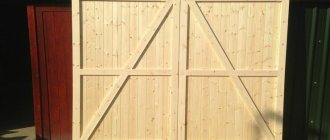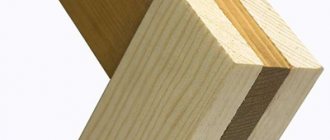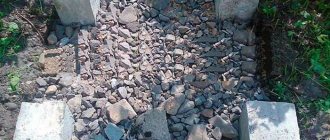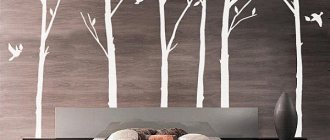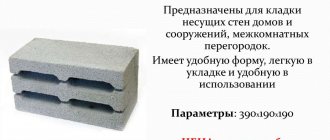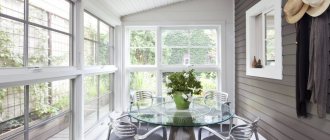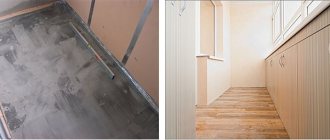When creating the design of a garden plot and allocating areas for planting various crops, the design of beds, paths and flower beds plays a significant role. Wood is perhaps the most accessible and most “obedient” material. We offer examples of how to make not only practical, but also aesthetic beds from boards with your own hands, in detail in the article.
High beds allow you to create the most favorable conditions for growing vegetables, herbs and berries in small areas
Advantages and disadvantages
In addition to solving problems with waterlogging, high beds in the garden allow you to sow or plant plants 2-3 weeks earlier: raised above the ground, they warm up more actively due to the fact that the sun warms the walls. This is also facilitated by the decomposition processes occurring in plant waste, which constitute a significant part of the backfill. That is why such beds are also called warm. If you place arcs on such a bed and cover them with spunbond or other similar material, then the harvest can be harvested even earlier.
The device is more problematic in regions with hot climates. The task in this case is not to better heat the earth, but to keep it from overheating. But this can also be solved: use materials with poor thermal conductivity, for example, wood, to fence high beds. For a better effect, you can make double walls, between which you can fill, for example, sawdust, lay polystyrene foam, or you can leave an air gap - better thermal insulation. In hot climates, it is better to paint the outer wall with white paint or whitewash it. It is known that light-colored surfaces heat up less. In this case, it will be possible to keep the root system from overheating: in the south the earth sometimes gets very hot and the higher the plant is, the cooler it will be. You can also stretch the same covering material over the beds. It not only retains heat, but also protects against overheating.
Beet harvest in a high bed
Raised beds can also be a good option on infertile lands. It is more convenient to lay out the imported soil in beds rather than distribute it over the entire site. The compost layer, which is located under the soil layer, contributes to maintaining fertility.
The problem of arid regions is also being solved. In this case, the inside of the fence for a high bed is coated with bitumen mastic or covered with film, and a roll of waterproofing material is placed on the bottom (on the mesh) (roofing felt will quickly rot, so it’s better to use one of the modern types of waterproofing). It will not be possible to achieve complete waterproofing, but it will be possible to retain moisture inside in sufficient quantities - yes.
Carrots - one to one. The best one is in a high bed, although the same variety was planted in a regular bed
As you can see, with a balanced approach, almost any problem can be solved. Raised beds have few disadvantages, but they are not without them:
- In most cases, you have to make a fence, and this costs money.
- The complexity of the process. Again, it takes time to make fences, and there is also a fair amount of earth and plant debris to move around, which is hard work.
- Mole crickets and other similar animals thrive in rotting leaves, branches, and bark. We have to fight them.
- Fertility has to be maintained by updating or completely replacing the “filling”.
That's all the shortcomings. If you decide to arrange raised beds, be prepared for a considerable amount of work. But the harvest will be many times greater. You can make one or two beds for testing. And then decide whether you need them or not.
Dimensions
There are no strict recommendations on this matter, and there cannot be: the conditions in the country are very different, and so are the people. There are sizes that many consider optimal.
On one site there are very high beds and not very...
So, the dimensions of the raised beds are:
- Height - from 20 cm to 50-60 cm. Look here what a difficult task it turns out to be. The higher the bed is raised, the easier it is to process - less bending. But more land and all the other “fillings” will be required. One more point: if a small bed may be covered with snow and will be covered from severe frosts, then a tall one will freeze through: the sides will also be open. For those beds where annuals are sown, this does not play any role, but for perennial strawberries, let’s say, this is a problem. Therefore, the height is chosen based on these considerations. According to the experience of many summer residents, the optimal height for strawberries is 20 cm. Then you can hope that it will not freeze.
- Width - from 60 cm to 1.2 m. Choose a distance so that it is convenient for you to cultivate the bed. A distance of 60-70 cm is chosen if the approach to the bed is only from one side. If you can reach it from both sides, you can make it a meter or more. It is important that the middle is processed without much stress.
- Length. Here everyone chooses based on the configuration of the site or their desire. There are no recommendations at all.
To prevent the bed from being too high, part of it can be buried: bury it 20-30 cm, and then put walls on top. The removed soil will be used for backfilling (there is often simply not enough soil), and the substrate from the lower coarse layers can be made thicker. And to minimize the cost of maintaining such a bed, you can use drip irrigation.
From tires
Waste truck tires are free and accessible material. A flower bed made of tires will no longer surprise anyone, but summer residents have gone further, and even experienced designers can envy their fantasies.
For a small garden bed you will need 2 tires.
- The sides are cut out.
- Tires are cut crosswise.
- They need to be unfolded and laid together with the cut edges.
- To fix the shape, reinforcement is driven into the ground from the inside, which will prevent the tires from curling up.
- Tires can be painted.
Related article:
Lazy vegetable garden
How can you fence high beds?
You can use anything that can hold the soil. The most durable curbs are made from brick, stone and concrete.
Concrete and stone beds can be made this way
But brick costs a lot, and it takes a long time to work with concrete. A concrete fence is made according to all the rules: first, formwork in which the reinforcement is laid, then it is poured with concrete and they wait until it sets. But the service life is impressive - decades.
Fencing for garden beds made of concrete is the most durable and will never “float”
Brick and stone fencing is also built according to all the rules: with mortar and bandaging. To reduce brick consumption, the walls are laid in half a brick. And so that the earth does not move it, the rows are reinforced with mesh.
Half-brick brickwork by itself cannot hold the soil. Support poles required
But even in this option, you will need to install support pillars every meter. If your soil is viscous, heavy, and often waterlogged, such walls can be squeezed out. Therefore, install wooden or metal supports that will support long walls or make small beds, as for a decorative vegetable garden.
Brick raised beds for decorative vegetable garden
Fences made of expanded clay blocks have proven themselves well. Even the voids in them can be filled with soil and plants with a small root system can also be planted there: for example, some types of greens and salads.
Fence for high beds made of expanded clay concrete blocks
They also make fences for high beds from galvanized metal and slate. You can use used slate, you can buy new, wave or smooth - it doesn’t matter. Cut the sheets into strips of the required width. There is no need to fear that it is harmful. Slate contains asbestos in a bound state, and it does not dissolve with water. It is harmful when it is sawed: dust rises and enters the body through the respiratory tract. To reduce the risk, wear a respirator and wet the incision area.
Raised beds made of slate
They make fences for the garden beds from plastic. Have you changed the siding? Use it. There are old plastic panels - they are used. But plastic requires a rigid base. It is made from a metal mesh made of thick wire.
Raised beds in wire boxes
The grids can become the basis for pebbles or pellets. Only in this case will you need a double frame, inside of which stones or some other material is poured. This technique is called “gabion” and it is used to make not only fences for beds and flower beds, but also fences. But to prevent water from seeping through the walls from the gabion beds, the inside of the box is lined with a thick film.
Backfill stone fence for raised beds
The most popular fencing is made of wood. You can use boards, timber, logs. Wood is good for everything, except that it rots.
Really high beds
And since all the conditions have been created in high beds to activate this process, destruction occurs quite quickly. You can slow down the process somewhat by painting the boards or impregnating them with a bioprotective composition. But there is still no guarantee against destruction.
Cutting boards can also be used for the sides of high beds
But you can use cheap, and sometimes even waste, material: leftovers from construction, slabs, old logs, pallets, etc. If desired, you can even make a fence from branches. It is only advisable to remove the bark: it is under it that there are many larvae and woodworms. Although...they will also process the wood debris that you place at the bottom of the backfill. But you don’t need too many of them either, so it’s probably better to remove the bark.
You can even make a fence out of branches
From the same branches, only freshly cut, you can make a wicker fence. And it will also need to be lined with film from the inside: to keep water and earth inside.
Read about how to make fences here.
The frame for the beds can be woven from fresh branches or laid out from stones
You can even use straw. It is tied into small bundles, which are connected to each other using wire. It simply couldn’t be cheaper, and it holds water and temperature well. The only disadvantage of this option is that such a fence will last for a maximum of two seasons, but rather one. But it can then be used as one of the layers.
Straw fencing
Bulk beds
There are high beds without a fence: the so-called bulk beds. The soil in them is poured in the form of hills.
Bulk beds
To improve drainage, branches are placed inside such a ridge. To reduce the height of the bed (for example, for tomatoes), it is deepened a little, throwing the soil to the side. After laying the branches, it is filled on top; there is often a need for additionally imported soil. If you cannot choose row spacing deeply.
Internal structure of bulk beds
The disadvantage of this kind of garden: when watering and during rains, the top layer of soil is washed away. That’s why they started making boxes - to avoid washing out the soil.
INSTALLING A REGULAR WOODEN CONTAINER
There is nothing complicated in making a ridge frame; it does not require special skills. To perform this you will need tools and raw materials, such as boards:
- Croaker – two small in overall size, two large.
- Support for the walls of the structure in the form of pipes - six pieces.
- Pneumatic and electric tools, drill.
- Bolts or cogs.
- Scoop.
- Measuring tape and angle.
Lesson plan:
- Connection of iron pipes with slab. Along the entire length of the wooden material, support pipes are attached using bolts or screws. The support is attached to the elongated slab in the same way, since the boards are large, the bars are installed in several places. One part of the support, which is sharpened, will stick into the soil. The size of the support is calculated so that one part is in the ground, which is added additionally, about twenty or thirty centimeters.
- Connection of all main parts of the structure. Part of the longitudinal slab is connected to the support by a pair of shortest ones. The opposite side is connected in the same way. At the end, it is necessary to check the entire structure for errors so that it is without gaps and strong.
- Frame installation. The structure is transferred to a special place in the garden, covered with earth and useful minerals. At the end, all dimensions and condition of the ridge are checked.
The wood frame for the bed has been made. You can start planting vegetation.
Layers of raised beds
Framing is only a small part of the job. The resulting box still needs to be filled. It must be said right away that the thickness of the layers depends on the height of the bed that you have chosen, so if any values are given, then they are purely approximate. In addition to the size of the bed, the thickness of the layer, for example, fertile, is influenced by the choice of plants: for some, 5 cm is enough, but for others, much more is needed.
Approximate layers for a raised bed
So, what to pour into a high bed - layers from bottom to top:
- A metal mesh with a fine mesh or a layer of geotextile is laid at the bottom. You can put cardboard. Mesh and geotextiles - protection against rodents and moles. Cardboard plays approximately the same role, but it is less effective.
- Large woody debris: thick branches, twigs, even logs and bars. This layer serves, firstly, for drainage, and secondly, moisture accumulates in the wood. The drier the climate in your region, the more wood you need. Moreover, the following wood layers too.
- Chopped small branches, bark. Other coarse plant debris will work: corn stalks, straw. Their task is also twofold. They store water and, when decomposed, release heat and nutrients. But when using corn trunks and straw, keep in mind that the bed will soon sink: these remains will rot quickly, but the yield will be high, and you can sprinkle fertile soil on top.
- Paper, thin cardboard. It is usually lined with a thin layer. Packaging cardboard is used more often, because glossy paper is not suitable, just like newspapers: lead paint is not at all what you need to fertilize plants with. If you have old unnecessary burlap (natural), you can lay it down.
- Layer of plant residues: foliage, grass, semi-decomposed sawdust. Be careful with sawdust: they strongly acidify the soil. So sprinkle them under plants that like acidic soil, or neutralize the acidity by covering them with a good layer of ash.
- Fertile land.
You can add a good portion of mature compost to the last two layers, as well as sprinkle it into the deeper layers. This will speed up the “readiness” of the raised bed for planting.
Read about how to make a pond at your dacha with your own hands here, and this article describes how to turn it into a fountain.
SUPERVISING THE READY RANGE
There is nothing complicated in looking after high beds; they need to be moistened, weeded, and hilled. You also need to walk along the ridge with a hoe in the form of a rake, this dry soil will be crushed, after which you can water it so that the water gets into all parts of the soil of the ridge.
In autumn and spring, special herbs for humus are grown, as well as grain crops. When pruned, such grasses become nutrients for plants in the beds.
In order to create such beauty in your garden, you don’t need many hours, special skills, etc. Summer residents make such wooden beds for a large amount of harvest. This bed is suitable for planting any crop.
When is the best time to do it and what to plant?
It is better to fill a high bed in the fall. During this period, there will be enough “material” and over the winter the processes inside will gain momentum. In this case, you can plant plants in the spring and hope for a high harvest. It can be done in the spring, but there are unlikely to be any significant differences in yield: the processes have just begun and will not have a noticeable effect on the fertility of the backfill. Although you will definitely feel the difference in the amount of water for irrigation: much less water is required.
One of the options for a high bed: metal mesh and reinforced polyethylene film
Plant rotation
In the year a high bed is installed, plants that require high fertility can be planted on it: cucumbers, zucchini, zucchini, pumpkin, any type of cabbage, eggplant, tomatoes, sweet peppers. The next year you can plant greens - spicy-aromatic and leafy. Root vegetables feel good in the second year.
After the second harvest, fertility must be restored. If the contents of the bed have sagged, in the fall they add good soil mixed with mature compost. If there is nowhere to add more, remove part of the top layer (to a compost heap or into another box as part of the backfill) and replace it with fresh soil with fertilizers.
High bed for strawberries
It differs only in that covering material is spread over the finished “pie”. Holes are made in it into which plants are planted. This option leads to the fact that moisture evaporates in minimal quantities, and weeds do not grow in the aisles. The second option - mulching the soil also works well, but evaporation is more intense.
Strawberries are doing well
The peculiarity of strawberries is that their roots are located mainly on the surface. Therefore, the fertile layer may be small. But this same feature leads to the fact that in severe frosts it can die. Although a decomposition process is taking place inside the high bed, warming the soil, if the bed is without snow and not covered for the winter, the root system may freeze.
High bed for cucumbers and tomatoes
In terms of its structure, it is no different. Is it just because poles and crossbars or stretched wire are needed at the edges so that you can tie up tomato bushes or cucumber vines.
For cucumbers and tomatoes, you need to take care of the garter
You can read about organizing automatic watering for your garden or plot here.
How long does charred wood last?
Since synthetic wood impregnations applied by hand wash out over time and have a negative effect on the soil, some gardeners protect the wood by firing. This proven method is one of the most effective.
Even in ancient times, people noticed that charred wood does not rot for a long time. Why is this happening?
- pathogenic microorganisms die under the influence of high temperatures;
- wood sugar burns out, and the wood does not attract wood-boring insects;
- the molten resin closes the pores of the material, making the wood less hygroscopic.
To process wood in this way, you can use a gas burner. For long-lasting protection, the thickness of the charred layer must be at least 2 mm. After firing, the material is immersed in water or moistened with a sprayer, then dried and cleaned of carbon deposits with a metal brush or a grinding machine. Burnt wood, additionally treated with oil, lasts a very long time - 60-80 years.
Burning wood must be carried out in compliance with all safety measures. During work, keep a bucket of sand, water and a fire extinguisher on hand.
DIY raised beds
Most often, questions arise not when laying layers in high beds, but when making the box. Since women are often involved in gardening, including making fences for garden beds, many aspects may not be clear to them. To clarify the most difficult ones, we present photo reports of making boxes from boards and slate - the most common fencing.
From boards
Several options for how to make high beds from boards were in the photo above. The main problem is usually the connection in the corners. The easiest way is to make them overlap: just put one to the other at 90° and nail them all the way through. But there are aesthetes who strive to do everything right. The correct way is to cut two boards at an angle of 45° and connect them that way. This is the option that will be demonstrated in the photo.
Planed boards treated with impregnation to slow down rotting
To make it convenient to fix the fence on the ground, vertical bars or pieces of board are nailed in increments of 1.2-1.5 m, the length of which is approximately 20 cm greater than the selected height of the bed.
We nail vertical bars so that the box is strong and can be dug in
The lower end of the block or board needs to be sharpened - this will make it easier to hammer the fence into the ground. Then take a miter box or circular saw and cut the edges at an angle of 45°. By placing two boards together we get a perfect 90° angle.
Correctly made angle
For a strong connection, we install a block on the inside of the corner, to which we nail the boards.
This is what happened. It just lies with its “burdens” up. They are driven into the ground
It doesn’t take long to make a fence for high beds made of wood, but it’s even easier to join the boards end-to-end and nail metal corners for strength (pictured below).
The simplest option
From logs
It is no more difficult to make a similar box from hewn logs. For example, this option: two long sides are made of logs, and short sides are made of pieces of boards.
The advantage of logs is that they are heavy, and due to their weight they will hold the ground well
Whitewash the finished fence: both protection from pests and a more attractive appearance.
Let's start setting up
From slate
When making beds from flat or wave slate, questions also arise about how to secure it. The easiest way is to dig it in. But this is not economical: you will have to make the stripes at least 10 cm wider and there is still no guarantee that the slate will not “float” in the spring. In the muddy ground it will simply be squeezed out en masse. It can be fixed, but it will take extra time and effort.
Therefore, most often, corners or pipes are driven in on one or both sides of the sheet, which clamp the slate and prevent it from deviating much. In the photo, the corners are driven in only from the outside: from the inside there will be pressure from the mass of layers of the high bed, so that the fence will not fall inward.
Fencing beds with slate
The junction of two sheets is secured with a special welded plate. For reliability, they can be bolted to a wooden block attached to that side.
A piece of reinforcement with a welded plate - to insure the joint of two sheets of flat slate
Another option is to make a frame. Attach a beam or corner to similar racks with welded plates - whichever is cheaper. And attach slate cut into strips to this frame (it holds well with nails, but it’s easier with self-tapping screws).
Frame made of timber in a fence for a high bed
Using the same principle - with guides - beds are made from plastic panels and other similar materials. As you understand, there is no need for particularly virtuoso skill here. The main thing is that it holds up well.
MATERIAL FOR USE OF EDGE CONSTRUCTION
For the construction of beds, different types of material may be suitable, such as boards, lathing, timber, slabs.
To understand what kind of material is needed to make the frame, you need to calculate your financial situation.
- Oak and maple are strong types of raw materials that will last for many years; this material is also resistant to dampness and various raking diseases, but the material is not cheap.
- Fir and alder are ideal, the material is strong and can withstand rain.
- Conifers are an excellent solution for garden bed designs. The material is excellent in density and can also be purchased at the best price.
- Spruce - the price of such material is very affordable, but not durable.
- Acacia - this material can be used to make a fairly strong structure.


